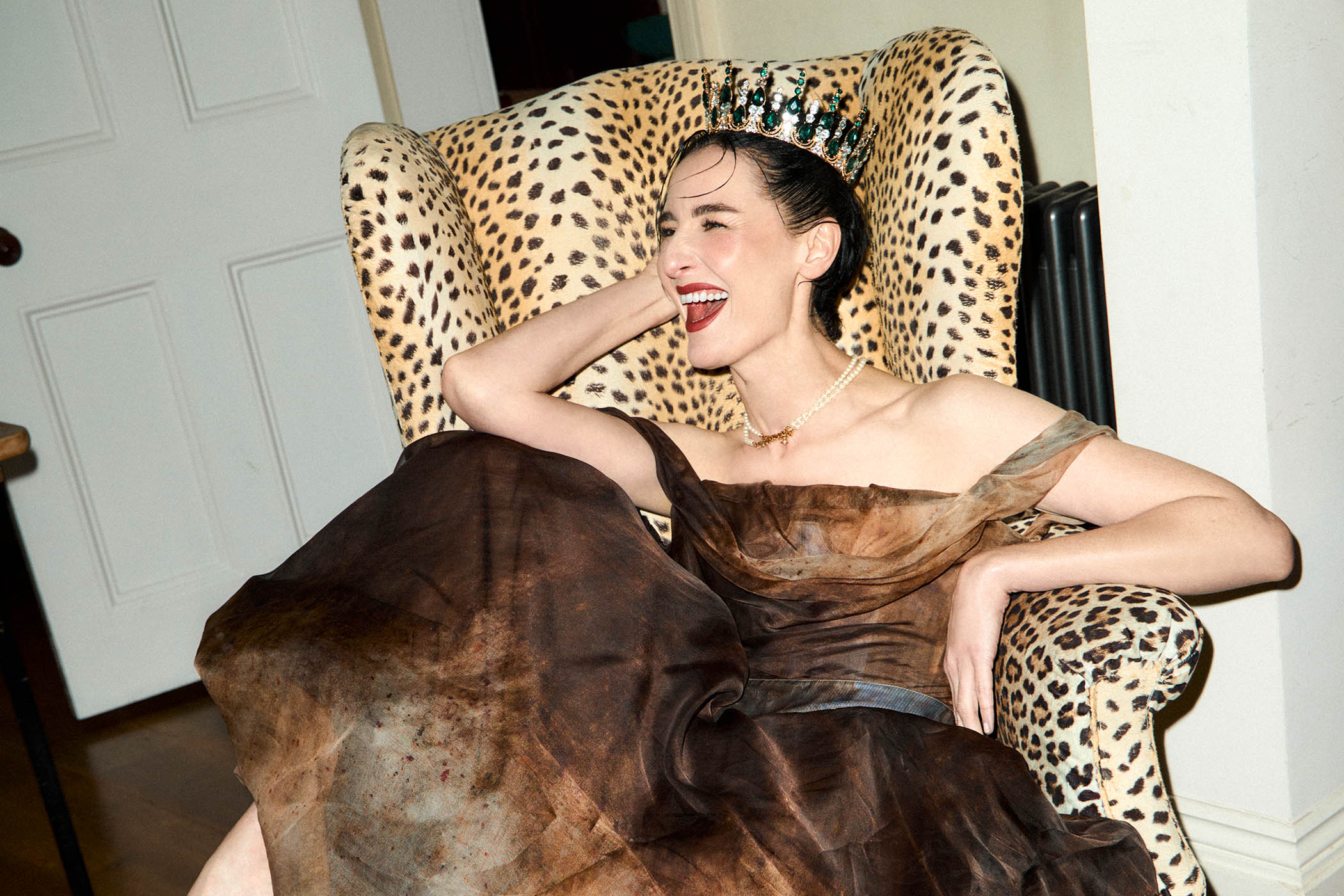Photographs by Andrew Woffinden
School had got out at half past three, and the sky was already pinkening between the London plane trees when Erin O’Connor’s youngest son entered a kitchen filled with stylists, a photographer and, over there, his mother in theatrical makeup and an oversized Burberry cape. “Why are there so many posh shoes in the garden?” Eddie asked, peering through glass doors at a neat line of Christian Louboutin flats and Vivienne Westwood platforms waiting beside the barbecue. The house – a grand, colourful villa in south London where O’Connor lives with her two sons and her sister, Kelly, and where Lego Minecraft creations are displayed in antique dressers and oil paintings of O’Connor jostle for space with school photos – is a place where the scars and prizes of modern family life are frequently pierced by extreme glamour. As O’Connor scrabbled to find Eddie some paper, a mammoth bouquet of flowers arrived, and she blushed while reading an admirer’s card before propping it beside the fruit bowl. Eddie wanted to show me his bedroom, so we clomped up the stairs as his mum prepared to be photographed in the bath in a couture gown and Stephen Jones hat. We call this, I explained to him briefly, “working from home”.
Since becoming a mother, O’Connor had taken a step back from fashion to focus on her kids, as evidenced by the homemade farmyard diorama and her general ease with a football. But this is her 30th year as a model, and she has decided to return to the profession full time. To celebrate the occasion, here we are at a photoshoot at her home that describes this new chapter – a merging of her two lives – and introduces her sons to the meat of it: the wires, the lights, the shoes that need a small ladder to step into. “I’m a bit nervous,” O’Connor whispers, stagily. “It’s the first time I’ve ever done this, and it’s a bit of a relief to know it’ll also be the last.”
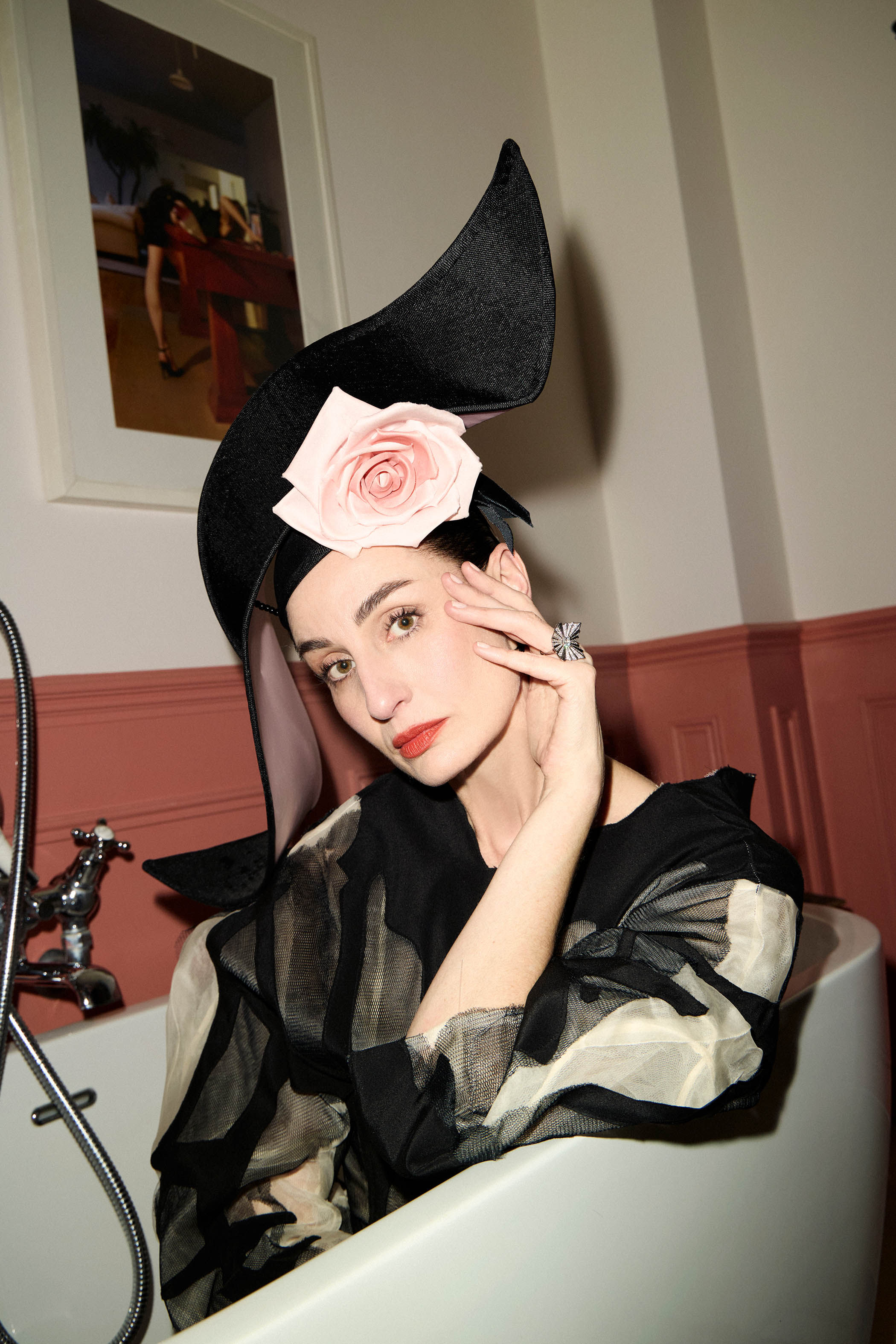
Dress by Steve O Smith; hat by Stephen Jones; and Southern Cross ring by Hannah Martin
O’Connor was spotted at The Clothes Show Live when she was 17, walking around with braces and smudged mascara. It was 1995. At 6ft 4in in heels, with a face like a mischievous Modigliani, she left the Midlands immediately to become one of the most famous models in the world. In the late 90s, her angular beauty was described by the fashion photographer Tim Walker as “freak chic”: her neck was too long, her brows outrageous, her nose (she said) “like Concorde”. It was suggested she should have jobs, both boob and nose, and she became known, she tells me later, as an “anti-beauty”. But as her confidence grew, her looks came to be read as “aristocratic” despite her working-class background, and androgynous – largely because before an early job the hair stylist Guido Palau chopped off all her locks.
In 2003, at 25, she was profiled in a documentary series called This Model Life, which propelled her from the catwalk into the public’s living rooms. Reviewing it at the time, the Guardian’s Nancy Banks-Smith described O’Connor as “so stick thin that, illuminated by the headlights of traffic far below, she looks like a giant insect”. The series revealed O’Connor to be not just a remarkable model but also surprisingly sensible – she took the cash a brand offered for her business-class flight and bought a seat in economy instead, saving the difference.

Bustier dress, top, tights and lace boots, all by McQueen. Albert wears his beloved Aston Villa football shirt
“I was a very timid person,” O’Connor told me. “I let my anxiety talk for me.” And yet she came across as confident and poised. “I naturally gravitated to her,” the super-stylist Katie Grand told me recently, because she seemed “so natural and easy, and had familiar experiences to me growing up.” The first big show they worked on together was Prada’s Winter 2003 runway. Prada had been “very ‘conceptual’, quite uptight”, Grand said. “I liked the idea of bringing sex and sass to the show, but I was incredibly nervous – I was brought in last minute. I felt I needed ‘my gang’ to model and support. I’m really not sure I would have known what to do without styling my incredibly good-looking friends.” She put O’Connor in a pencil skirt and buttoned-up blouse. “She was perfect,” Grand went on. “Incredibly cool and sexy, and still a bit rough. She had that very ‘love on the Left Bank’ feel.”
O’Connor’s career exploded quickly – she walked for Dior, Alexander McQueen and Chanel, and she was the face of M&S. In 2003, Karl Lagerfeld said she was one of the best models in the world. Jean Paul Gaultier said she wasn’t just a model – she was art; she was theatre. And she was fun, too. The designer Erdem Moralıoğlu, a frequent collaborator, remembers fondly a fashion awards “where she joined me as my guest, and we sneaked out for martinis and burgers”. She was wearing his skeletal corset dress in hand-draped tulle, and “looked like a Hitchcock heroine”.
In 2007, O’Connor became vice-chair of the British Fashion Council, working with Sarah Brown to push for legislation that ensured models must be over 16 to walk in London Fashion Week, and set up the Model Sanctuary, a house where, during London Fashion Week, models could rest and eat, and talk to nutritionists and therapists. “We were making an appeal to an industry that I love,” she says, “and that also drives me mad. It’s like any good long-term relationship.”

Fringed mohair cape, ring and bracelet, all by Burberry; Joan boots by Lili Curia
Two years later she launched All Walks, an organisation devoted to increasing diversity in fashion. Despite claiming now to be “the least political person you’ll meet”, her activism has earned her an MBE. In 2014, she was one of the highest-paid models in the world; and then, after a fertility journey that was “not an easy ride”, she had her first child. For the first time since her teens, she decided to step back from the catwalk, dipping in only occasionally or for particular friends. Now, on this big anniversary, she’s returned to work – wiser, wittier and ready to talk.
Three days after the photoshoot at O’Connor’s home, we met for breakfast at the restaurant at Claridge’s. She waved shyly as she approached, in a crushed-velvet blazer that she hung on the back of her chair. Her hair was slicked back from her face and, as she spoke with increasing passion, her fingers quivered. Her nerves about the shoot surprised me – but, reflecting later that evening, she realised it had felt important. “If I’m going to celebrate 30 years of being in my industry, the boys are such an overwhelmingly large, gratifying part of that and a renewed reason for me to want to keep going,” she said, slightly embarrassed at her earnestness. She is keen to show her sons what work looks like. “It’s a privilege to have both,” she said. “To have access to my career and to have my family present. The two inform each other.” Including them in the shoot was a chance to show her children “the importance of being self-sufficient and independent. How to just… keep on trying.” A cappuccino silently arrived on the table and the waiter discreetly bowed.
Over the past five years, O’Connor has split from the father of her children, the Irish businessman Stephen Gibson (who has moved to a house on the same street), recovered from a year of post-viral fatigue syndrome, entered perimenopause (she read Miranda July’s novel All Fours twice, then sent it to all her friends), and discovered she has ADHD, a diagnosis that brought her unexpected clarity and relief.

Dress, bracelet and earrings, all Givenchy by Sarah Burton
The fatigue, she told me, “was like being force-fed sleeping pills and trying to swim as fast as you can through water”. And working in that state felt “like being in my car on full rev, but I’m up against a brick wall”. When O’Connor first discussed her ADHD diagnosis publicly, in 2021, she received many emails. Was there one that stuck in her mind? “There was one from a senior mental health nurse of 40 years plus, and she berated me for lying about my diagnosis and for clogging up the system.” There were echoes here of health secretary Wes Streeting’s suggestion, with the apparent aim of cutting the benefits bill, that neurodevelopmental conditions are being overdiagnosed, along with rightwing fears of “‘wokeness’-gone-mad”.
There comes this brilliant moment for me where I’m literally untouchable. No one can tell me off, or that I got it wrong
Despite emails such as this, she said, the diagnosis “gave me peace” – many of the things she’d had trouble with during her life, including socialising and her frequent feelings of overwhelm, suddenly made sense. “Now I have that information, I feel more secure, ironically, in my abilities. The biggest thing that lifted for me was fear. I hadn’t realised that I was masking” – a strategy used by some neurodivergent people to fit in – “so damn heavily I had made it an art form.” Which was interesting, considering that her success had been in performance, in posing as a series of characters – often powerful, sometimes sinister. “But what I now realise is, I was simply hiding. I’m the most willing chameleon you’ve ever met. And, finally, through knowing that there were things about me that I could be more compassionate towards, I showcase it differently.” The photos she poses for now are “very much me. The healthier and better I feel, the more of me emerges in my images. You’ll see who I am.” She shrugged loosely and smiled.
O’Connor became famous for her gameness and bravery as a model. During an Alexander McQueen show, she emerged into an “asylum” in a dress made of razor clams that cut her skin. Her father, in the audience, wept. “Anything that was deemed terrifying to another model was absolutely reassuring for me,” she told me. “But walking into a room, doing a casting, exchanging small talk, was nothing short of terrifying.” The photoshoots were where she found herself. “I don’t know if I’ll ever be able to convey the feeling, truly, that excites me more than being held in a harness, 30ft in the air, being struck by imaginary lightning. Because there comes this brilliant moment for me where I’m literally untouchable. Nobody can tell me off. Nobody can tell me I got it wrong. Nobody can tell me it’s not good enough. And so for this very timid, still introverted person who I am, it’s like… the weekend.” She will “always be addicted to that,” she went on. Though it may have been detrimental in her personal life, causing anxiety and exhaustion, it was the “masking” – the performing and pretending – she has come to realise, that made her a supermodel.
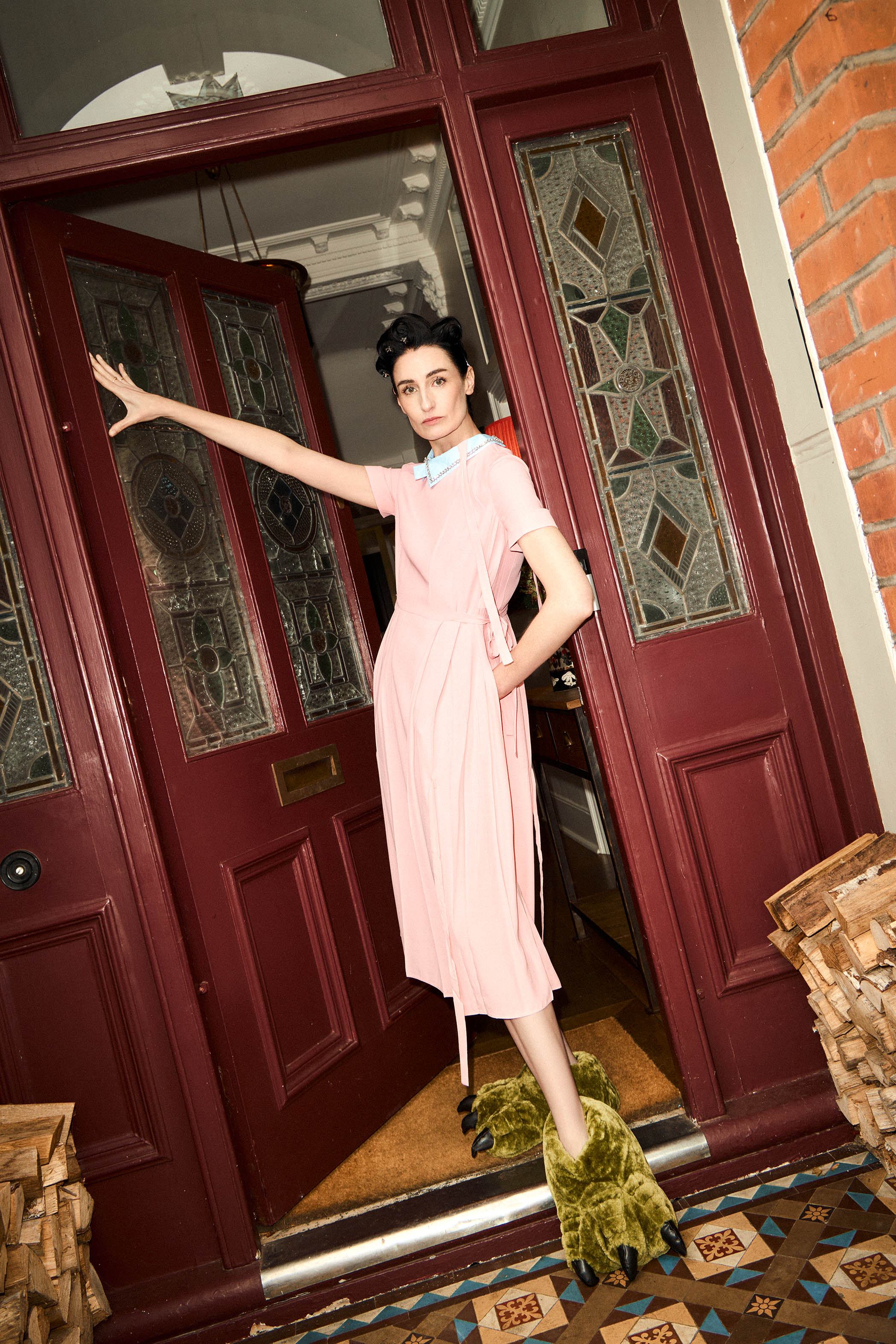
Pink silk dress by Prada
It was here, at Claridges, that O’Connor recently threw a party to celebrate her career – the guest list included models, school-mum friends and family (her sons got room-service burgers in bed). After the elation, the “snogging”, the dancing, she started looking back at those three decades in the industry with a more critical eye. “I used to be proud of the things I’d survived,” she told me. “Which is not right, necessarily. Like, being drawn into that political arena, playing two very definitive roles – the model and, as vice to the chairman at the British Fashion Council, the poster girl of the size-zero campaign.”
This was the beginning of a national conversation about the fashion industry’s promotion of extreme thinness. But O’Connor, as a BFC spokesperson – 6ft 1in, size 10 – found herself objectified and villainised. She later said she had been diagnosed with post-traumatic stress as a result of the criticism. “Every day was sort of... mildly terrifying. I didn’t know whether I was going to wake up to another humiliating spread of dodgy pics of me or commentary from leading psychologists or authors. I felt held hostage.” She took a long drink of water. “This was about a mental health crisis. And I wanted to acknowledge that, but at the same time my own mental health was taking a battering.”
She was regularly called upon to discuss body image and, inevitably, her own body. There were political events, interviews. At a televised roundtable discussion she was invited to debate with one of her favourite feminist authors. “I was excited. I relished her writing. She was fierce.” O’Connor introduced herself, “but [the author] wouldn’t take my hand. It felt like a rejection of the highest order. She had shot me down because, due to my job, she didn’t value me as a person.”

Fringed multi-coloured dress by Roksanda; and black mules by FitFlop x Roksanda. Eddie wears vintage Burberry hoodie from Rokit; and banana boots by Charles Jeffrey Loverboy
In her 20s, O’Connor began to write a memoir but discovered she couldn’t finish it and returned the publisher’s advance. Throwing her head back, she mimed exhaling in extreme relief. “If I read it now, it would have been quite shattering – it would have been what I felt was the most palatable version of me, which has very little to do with who I am.” It would have been another performance. But (along with conquering her sleep, and finding the right HRT), one of her current ambitions is to revisit that memoir – to write it properly, knowing what she does now. Stories about her childhood have been returning to her: the worm she pitied in the garden and wheeled about in her dolls’ pram; the books she kept under her covers for fear they would get cold; the way that, from the age of three or four, she was labelled “slow” at school. She reached over the white tablecloth to touch my hand. “Nobody knew about neurodivergence then.” And stories from modelling, too, including the times she’s proud to have walked away from jobs because “I realised that living with myself would be too painful if I didn’t allow my own dignity to sit with me when it mattered.”
The first was on a shoot in a roomful of people. She asked for somewhere private to change; they offered her a cupboard. “But for some reason, the designer took it as an insult that I had requested privacy. He came in as I was getting changed and he swore at me in Italian. And I was very calm, but I put my own clothes back on and I walked up the stairs and left, and I never explained myself.”
The next time, she was in her late 20s and more established. “The designer was extraordinarily powerful and they called me out for my body and its appearance whilst I was naked, again in front of others. So I put my clothes back on, very calmly, and left.” The most hurtful experience, though, she said, began backstage at a show in Paris. She was being dressed by a young British woman who was struggling. “She was out of her depth and I felt really quite sorry for her. It’s very quick. It’s quite high stress.” She helped her, said goodbye, and hurried out on to the catwalk. “It turns out she was an undercover journalist for a tabloid newspaper, and she was writing a story about how the girls behaved and our bodies.” When O’Connor saw it in print, “I reacted with utter humiliation. It was a public flogging.” She held two hands to the red cotton of her chest, to the racing of her heart, and behind her a businessman bellowed about his eggs.
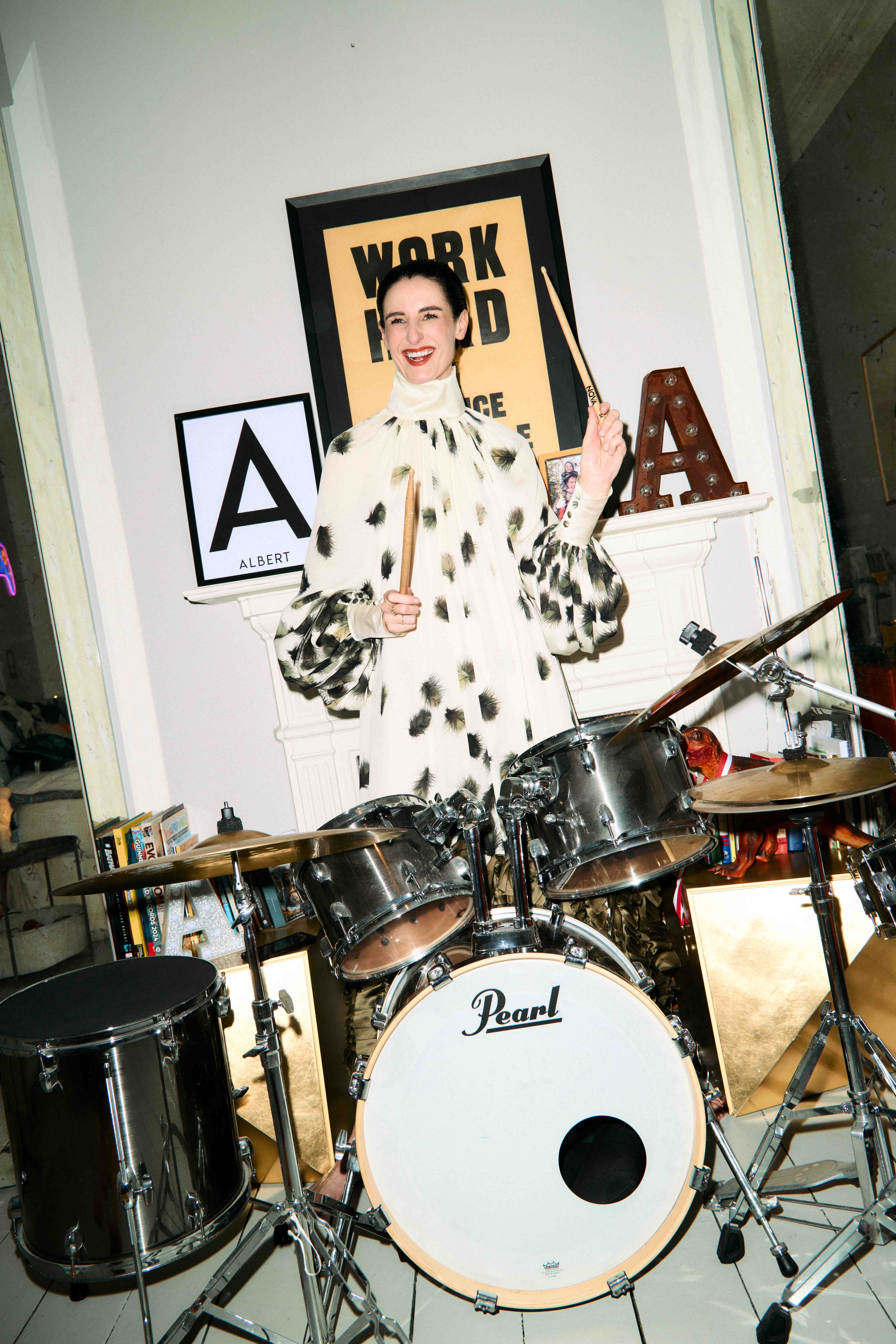
Silk twill dress by Giles Deacon; platform shoes by Harris Reed X Roker
On the photoshoot at her house, as parakeets screamed across the darkening garden, O’Connor ate a bowl of pasta between costume changes. On the wall by the kitchen table, half hidden by a hanging fringed Roksanda gown, was a printout explaining what a tantrum means (“I’m overwhelmed”; “I love you and feel safe with you”). Propped on the radiator were whiteboards reminding Albert and Eddie of their bravery, strength, imagination. Her two lives, fashion and family, overlapped here in a way that made parenting appear almost as glamorous as the gowns.
“But,” she told me quietly, “this is something that’s also indicative of me as the performer. Anything that you see as lovely or perfect or joyful is often coming from a place of adversity.” The whiteboards were carefully placed, she pointed out, to be present during homework horrors; the tantrum printout also had the startling reminder that your children didn’t hate you.
I know you shouldn’t separate yourself, she but – I do
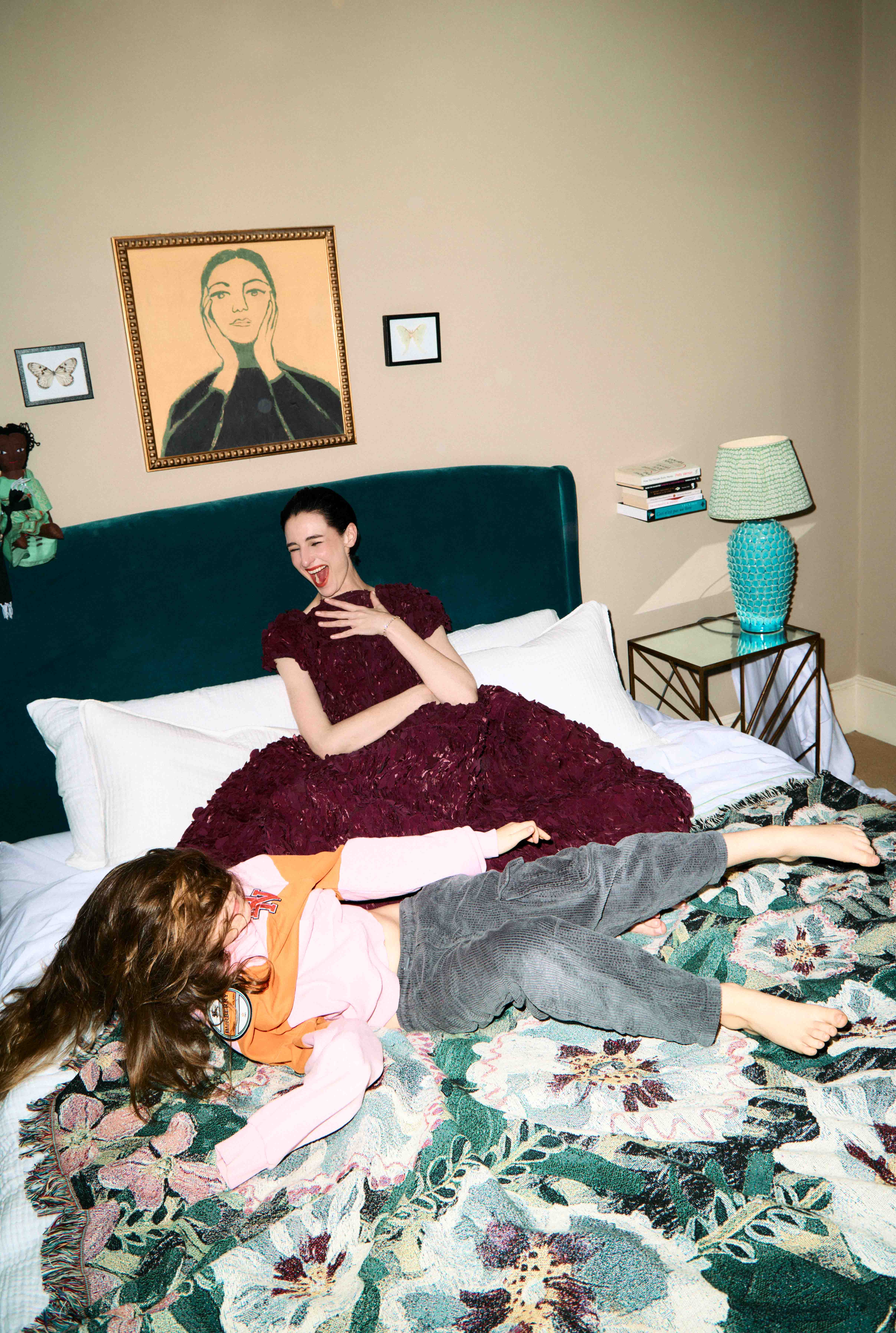
Midi dress with floral embroidery by Erdem; and diamond bracelet by Anabela Chan
She finds herself, she said, bolt upright at 6am and remembering with shock that she is a mother. “Oh God,” she said, weakly. “Jesus.” While her public image was always poised, a little austere, at home “it is a conscious decision for there to be colourful chaos and general warmth and mismatched abundance. Being able to embrace the person I really am with my favourite people.” And at the same time, it’s liberating to do… her: to do the Erin O’Connor who has been on 11 Vogue covers, who became the only non-royal face to appear on a first-class British stamp, and who this week climbed into the bath in couture. “I know you shouldn’t separate yourself,” she said, “but – I do.” Her sons groan when they see her walk downstairs in red lipstick, she told me, because that means the separation is happening – that she’s going back to work.
The industry has changed a lot in her 30 years modelling. It’s more organised now, she said, more commercial. “But what I’ve learned, which has been very sobering, is that you can embrace the organisation behind the scenes, but nothing actually changes for me when I go out.” She gestured to an imaginary catwalk, and the people and the lights. “I still feel the same adrenaline. The same liberation. There’s nobody who can tell me to stop. It’s just a moment that is entirely my own.”
Top image: Erin wears bustier gown in printed silk organza and necklace, both by Vivienne Westwood; and crown, Erin’s children’s
Hair by Bjorn Krischker at The Wall Group using Maria Nila; makeup by Rocio Cuenca using Cle de Peau Beaute; fashion assistant Sam Deaman; creative Helen Seamons
